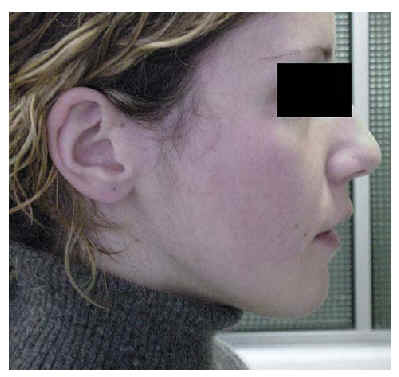INTRODUCTION
The auriculotemporal nerve syndrome is characterised by erythema, sweating, heat and pain localised to the cutaneus distribution area of the auriculotemporal nerve in response to gustatory stimuli, and it is a consequence of damage to the parasympathetic fibres of that nerve1.
In the clinical practice, a great number of adverse reactions to foods may be misinterpreted as allergic reactions. In adults, it is usually result of surgical injury or trauma to the parotid gland2. In children, it is uncommon, and it may be confused with an allergic reaction because it occurs when solid foodstuffs are introduced into the diet; this can lead to inadequate elimination diets in children3.
CASE REPORT
A 21 year-old woman suffering from pollinosis presented, in the last 8 months, erythema, sweat and heat in her right check after the ingestion of several foods such as chocolate, fruits (apple, pear, orange, banana and peach), and nuts. The erythema appeared immediately on mastication and disappeared in five minutes without treatment. Among her antecedents, she did not refer the use of forceps in her delivery, but she fractured her jaw 2 years ago.
METHODS
Skin prick test were done with a series of commercially available inhalant allergens (grass, weeds and tree pollens, house dust mites, cat and dog dander and molds), different fruits (strawberry, apple, orange, banana and peach), nuts (almond, hazelnut, peanut, walnut and sunflower seed) and cacao. Strawberry, apple, orange, banana, peach, almond, hazelnut, peanut, walnut, sunflower seed and cacao were prick-prick tested in our patient. Histamine dihydrochloride at 10 mg/mL and physiological saline at 0'9 % were used as positive and negative controls, respectively.
Total serum Ig E was measured by the FEIA CAP system (Pharmacia Diagnostics, Uppsala, Sweden). Specific serum Ig E for apple, almond, hazelnut, peanut, walnut and sunflower seed was measured by CAP method (Pharmacia Diagnostics, Uppsala, Sweden), according to the manufacturer's instructions.
An open oral challenge test with apple was performed.
RESULTS
Prick tests to common allergens were positive with grass pollen and olive tree. Skin prick tests and prick by prick to foods as almond, hazelnut, peanut, walnut, sunflower seed, cacao, strawberry, apple, orange, banana and peach were all negative.
Total serum Ig E was 612 kU/l. Specific Ig E antibodies to apple, almond, hazelnut, peanut, walnut and sunflower seed were negative (< 0'35 kUA/l).
Open oral challenge test with apple was positive reproducing the symptoms. The patient presented immediately on mastication of a small piece of apple, erythema and heat in her right check, and five minutes later she presented sweat in the same localization too (fig. 1).
Figure 1.--Facial erythema after eating an apple.
DISCUSSION
The auriculotemporal nerve syndrome, also known as Frey's syndrome, Baillerger's syndrome or Dupuy's syndrome, consists of the development of facial flushing or sweating over the distribution of the auriculotemporal nerve immediately following eating or drinking in response to gustatory stimuli4.
It was described initially by Duphenix in 17575 and published by Frey in 19236.
This syndrome is consequence of a parasymphatic nervous fibers lession; in adults, it results from traumatism, surgery or infection to the parotid gland. In children, it has been related with the use of forceps in the delivery1,3.
As the pathogenia, the damage of the auriculotemporal nerve, gives place to an aberrant regeneration of the parasymphatic nervous fibers that occupy the place of the sympathetic fibers in their union to the sanguine vessels; so, with the mastication, the aberrant fibers are stimulated, producing a pathological vasodilatation with local erythema and sweat3,7.
The symptoms usually appear several months after the trauma. This is probably related to the time needed for nerve regeneration.
In adults, sweating is the predominant symptom, and erythema may be associated. In contrast, in children, the sudoration is unusual.
This is a benign pathology in children, so they do not need any treatment. In adults, there are several possible treatments such as atropine, antihistamines, botulinus toxin, irradiation and surgical resection of the auriculotemporal nerve. However, these treatments have been unsuccessful or carry a high risk of complications1,2,8.
Beck7 described this syndrome in several children with epilepsy in the first years of their childhood. It is related to other diseases of the central nervous system, so Reche3 described a 4 year-old boy diagnosed of syndrome of Klipel-Treaunay at the age of 2 that referred the use of forceps in his delivery.
Our patient presented the symptoms 8 months ago, and she referred a trauma with fracture of her jaw 2 years ago. The food allergological study performed was negative. Because she presented mild symptoms, no specific therapy was recommended.






